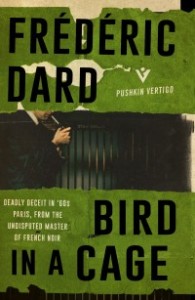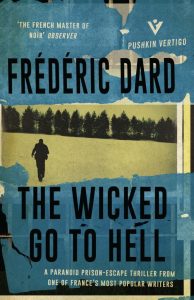Bird in a Cage – Frédéric Dard
 Pushkin Press, with their Vertigo imprint, deserve a huge round of applause from crime fiction lovers for publishing in English a selection of thrillers by Frédéric Dard, one of France’s most prolific and influential crime writers of the XXth century.
Pushkin Press, with their Vertigo imprint, deserve a huge round of applause from crime fiction lovers for publishing in English a selection of thrillers by Frédéric Dard, one of France’s most prolific and influential crime writers of the XXth century.
‘Bird in a Cage’ was written in 1961 and yet feels utterly contemporary, in the way that great crime writing, great writing actually, does. It’s a short, sharp story featuring a handful of brilliantly portrayed characters, and it is structured as intriguingly and cunningly as an Escher drawing.
Frédéric Dard wrote no fewer than 284 thrillers, under at least 17 different pen names. His most famous creation was San-Antonio, a hugely popular French secret agent whose adventures he penned under the San-Antonio alias between 1949 and 2001. ‘Bird in a Cage’ is one of Dard’s stand-alone novels, and a very fine specimen of his work.
It’s a first-person narrative from the perspective of one of the two main characters, a man in his early thirties called Albert Herbin, who returns to his mother’s home in Paris, his childhood home, a few years after her death. Dard’s writing is atmospheric and mesmerising from the outset. We know nothing about Albert, and the truth will come out gradually, layer by layer, Dard being economical in his style as he is with epiphanies, and yet highly effective at putting the reader inside Albert’s mind.
It is Christmas eve and the newly returned Albert, alone in the old neighbourhood he lost touch with, meets a young woman, Mme Dravet, and her little daughter, at a restaurant. They too seem to have nothing planned for the festivity, and a tentative friendship develops in the time of a meal. Mme Dravet – whose first name the reader and Albert will only learn on the last page – reminds Albert of his dead girlfriend Anna. Getting to know her becomes an imperative, and the young woman, demurely, gradually lowers her defences. After dinner, she invites Albert to the flat where she lives with her daughter, not far from Albert’s own. The nightmare for Albert is about to begin.
It’s virtually impossible to say anything more about the plot without spoiling it, but a dead body does indeed appear, and the police will soon start an investigation. Dard sets the scene slowly in the first few chapters, but then he springs surprise after surprise on Albert (who actually does spring a couple of major ones himself) and the reader, each and every twist interlocking neatly into the next, like a devilishly clever mechanism.
The action takes place over less than 48 hours and in no more than four actual locations, most of them with a peculiarly claustrophobic feel, which Dard subtly contrasts with the Christmas atmosphere surrounding his characters. But he doesn’t need the great outdoors, nor high-octane car chases or gruesome violence to capture the readers: what goes on in the hearts and minds of Albert and Mme Dravet, and the twist and turns of the narrative they fashion for each other and the world outside is sufficient to make ‘Bird in a Cage’ a truly remarkable crime novel.
It is impossible to introduce Dard as an author without mentioning the other XXth century master of French-language crime fiction, Georges Simenon. The great Belgian author was as prolific as Dard, if not more, and published his first crime novel in 1927, about 20 years earlier than Dard. Their output did overlap for nearly three decades though, and they greatly respected one another. With good reason. I personally don’t know Dard as well as I do Simenon, but reading ‘Bird in a Cage’ I found the same ability in sketching character and atmosphere, the same compunction to explore the recesses of people’s minds frankly and objectively. All of Simenon’s protagonists, hero and villain alike, are ultimately ‘normal’ people, in whom only a tiny deviation from the norm creates frightening but wholly believable sinners or saints. In ‘Bird in a Cage’, Dard shows similar powers of observation, and the same ability in producing a stunning plot out of seemingly everyday material, enough to make me want to read more of his work.




